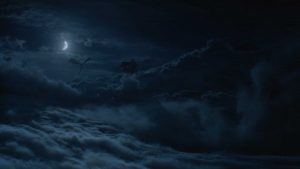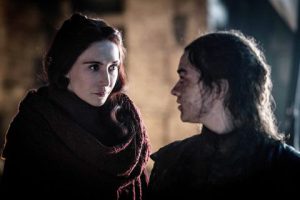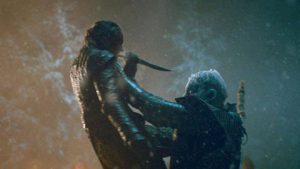Game of Thrones 8 Episode 3 – Armageddon. The Long Night.
In this episode, the long-awaited battle between the people in the north and the world of Satan with his hosts was fought. According to one of the references on which the plot of the series based, one can relate it to the Battle of Armageddon in the Old Testament/Torah. This war, which is about the spiritual level, was portrayed as the bare horror for the characters involved. This was the battle of gods and faith and, accordingly, of survival and religion. A battle of daughters and sons.
Attention, even today it is not possible without spoiler. And, also for this short, weekly contribution, I must limit myself to selected aspects that are above all dramaturgically of interest and have not already been broadly discussed in reviews.
Most of the still living central characters of the series have survived this slaughter. Dramaturgically these are still needed for the last worldly struggles, the dissolution of sub-plots and the central conflict over total power, the throne.
The episode begins in the night, before dawn, in anticipation of the attack, final preparations are made. For example, we see Sam (John Bradley) getting two daggers pressed into his hand, about which it is told that he won’t spend time in the crypt with the women and children, as Jon (Kit Harrington) advised him.
Tyrion (Peter Dinklage), on the other hand, grabs a bag of wine before retreating into the crypt as ordered by Daenerys (Emilia Calrke). Bran (Isaak Hempstead Wright) and Theon (Alfie Allen) with his men pass Tyrion to wait for the Night King (Vladimir Furdik) at the red tree as lure.
The following shots show men and women waiting in tension and moving into position. The music and an associative montage of images combine these observations into a suspenseful opening sequence that familiarises us with the space in which the action will take place, according to an exposition. Even though Winterfell is generally familiar to the audience, this is about the battle formation that implements the plan from the central scene of the last episode and gives the space new dimensions and functions. Woven in are details such as the repeated reference to the cold, weapons get provided, cries of dragons heard. Excitement also arises from the sound design, which underlines the silence and does not artificially incorporate additional emotional softeners. The music takes up the motifs of the marching up and the heartbeat, whereby tension is achieved, one almost holds one’s breath.
The surprising element to be expected in this episode was the return of Melisandre (Carice van Houten) at the end of the exposition, with which the vertical dramaturgy of this episode is given an additional individual arc. The battle is central. Here again, the narrative of a personal fate is connected with the collective strand, as it is typical for an open dramaturgy. (cf. Klotz 1980) Of course, the figure of Melisandre must play a role in the decisive spiritual battle, since in the sense of the action it is also about the establishment of the new religion, the recognition of the God of Fire in this case. This is underlined by the character at least twice: once in the situation where Beric Dondarrion (Richard Dormer) finally dies, because his task will be fulfilled with the battle and „the Lord“ does not have to bring him back, and at the end of the episode, when she goes to her death, since her task is fulfilled. Through her and her work, her God helped to win this battle and also to destroy the Night King. The fire destroyed the ice.
This is of course linked to the narrative strand Arya/Jon and the confrontation with the Night King. The figure of Melisandre, in the situation she first met Arya (Maisie Williams), predicted that she would bring death to people of different eye colours. There is an echo to this dialogue in this episode when Arya says: „You said, I’d shut many eyes forever, you’re right about that too.“
Melisandre lists the colours, the last of the colours she mentions is blue eyes. This, and the question about Arya’s attitude to the God of Death, seems to be like a wake-up call to Arya. The end of this scene is composed in such a way that Arya walks past the camera, followed by a cut to the shot of the clearing where Theon stares into the dark and awaits the attack. The image composition and editing create a connection between these two situations.
The constellation Daenerys – Jon/Aegon is much discussed on the explicit level. Will she be queen? Will/will they remain a couple? I can’t answer that. I assume that, according to the introduction of the figure about her (half-)brother, she finally hands over the plot and the power to her next male relative, Aegon (Jon).
Refined but equally dramaturgically consistent is the fact that the episode ends with Arya overcoming the Night King and not Jon/Aegon.
As already mentioned in the last text, it is evident that references to the legend of the Grail are adapted in the design. Jon/Aegon is a variant of the Parzival, which is hidden by its mother in the forest, far away from the knights, far away from the royal house, has no idea of its origin, but then is responsible for the rescue of the country. He is rather the spiritual young man associated with the spiritual, higher power. This land is sick and sunk in war and misery because the king is wounded and no longer able to lead the country. In order to save the country, Parzival must find the Grail together with a very worldly knight trained in the martial arts, and only if all three together make it to the throne can the land be healed and peace restored.
Now Jon and Arya were already welded together in the second episode with a means proven in the theatre as a pair of figures, in which Jon had a valuable object made, which he presented to Arya, and they embraced on it. Gift and body contact weld figures together traditionally. In this way, these figures could also lead alternative plot strands over the course of the series, which complemented each other and related to each other. According to the object, Arya became a fighter. She has learned to handle this weapon and various others. She’s Gaiwan.
So it had to be Arya who overcame the Night King. She is trained to be the perfect fighter, has resisted the pull of evil, and she is the counterpart to Jon/Aegon. The audience got already prepared for the probability of this situation with the one in which Lyanna Mormont (Bella Ramsey) stabbed the undead giant. She hung in a similar stranglehold in front of him, like Arya in the hand of Night King, and stabbed the giant with a dagger.
Now the question arises, who or what is the Grail? Bran, maybe?
Another consideration that seems worth considering to me is that Tyrion is sent to the crypt and has to stay there. Neither about the figures of the Daenerys nor of Sansa (Sophie Turner) is he believed to have an active part or an intelligent decision in this situation. On the contrary, he is asked to face the truth that he is useless. Until now, the character had been guided in such a way that she acted as a kind of film clarifier and therefore always either had an overview and commented on developments or influenced decisions in her progress. This was still the case in the last episode, where the character was used, among other things, to convince Jaime and the audience of the positive aspects of the Daenerys and to confirm them as the future queen. Is this change preparing us for Tyrion’s departure or is it just another smart move in the game with the audience’s guesses? Perhaps this constellation only served to solve the conflict between Sansa and Tyrion through this created constellation and also to close this secondary strand.
Dramaturgy is not a format template but allows a play with models, rules and traditions, which is why a dramaturgical analysis of such an intricate work has its limits in forecasting. Mainly when, as in this series, very sophisticated operations are carried out with constant figures and variable figures. From my point of view, the only characters who seem for sure to be part of the action until the finale are Jon/Aegon and Arya.
I also assume, but of course, I can be wrong that Cersei won’t be taken out of the game in the next episode, as many critics and fans expect. The next episode will probably first bring a retarding moment before the battle for worldly power will be waged to complete the arc of Cersei intrigue, the last parent-generation figure in the game with ambitions for the throne. The characters of Cersei (green eyes) and Daenerys (blue eyes) resemble each other in the unconditional, autocratic and fanatical will to absolute power.
Kerstin Stutterheim
bibliography
Klotz, Volker. 1980: Closed and open form in drama (1969). 13 ed, literature as art. Munich: C. Hanser.



